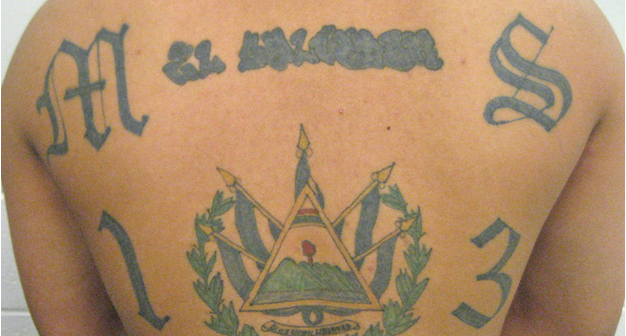July 24, 2018 (Originally published in August 28, 2010)
Ines Rivera
Investigative Reporter
Living the Life
Photo: Courtesy of U.S. Immigration and Customs Enforcement
Brenda Paz’s murder on July 13, 2003 marked the beginning of an aggressive and revitalized effort to combat the Mara Salvatrucha, the largest and fastest growing gang in the United States. Tracked in 42 states, according to the 2009 National Gang Threat Assessment, as many as 40,000 to 50,000 MS-13 members exist worldwide, with 8,000 to 10,000 living in the United States. Known for its brutal use of the machete, members are involved in smuggling, transporting, and distributing drugs. Some are also involved in other illegal activities including assault, auto theft, car jacking, drive by shootings, extortion, home invasion, homicide, money laundering, rape and weapons trafficking.
Paz’s death brought attention to the persistent problem of gang violence across the country and the expansion of MS-13. According to Robert Vilchez, Coordinator of the Arlington County Gang Task Force, the region of Northern Virginia had been in denial prior to 2003, despite the steady increase in gang activity, and the 3,000 MS-13 members living in the area at the time. Paz’s death was a wake up call, debunking the belief that gang violence was only prominent in inner city neighborhoods.
Paz went by the nickname of “Smiley,” and after emigrating from Honduras to L.A., she ran away from home, following a boyfriend to the East Coast. She was fourteen years old when she was initiated into MS-13, which became her surrogate family. There are many social issues that make youth more susceptible to joining a gang: dysfunctional families, low academic performance, lack of supervision, low self esteem, no positive male role model, lack of attention, etc. Robert Vilchez points that a major contributing factor is reunification.
Many of the youth that join gangs in this region come from families who have emigrated and who were once fragmented. These kids for large periods of time are raised by extended families, as their mothers and fathers work two or three jobs to then bring them or relatives here to the north. Often, when children or adolescents arrive they’re strongly impacted by a harsh reality not expected; this coupled with the fact that there is a lack of supervision because their parents must work to make ends meet, plays a role in their decision to join a gang. As Vilchez puts it, “The gang is love, attention.”
A year before her death, Paz became a federal informant, sharing information about MS-13, from its recruiting tactics to secret hand signs used to communicate, and crimes she witnessed ranging from robbery to drug trafficking and murder. The information she supplied strengthened sixty cases against MS-13, and yet was also the reason why she was killed. The FBI had put Paz under the Witness Protection Program, but after being moved from Silver Spring, Maryland to Philadelphia to Minnesota and then Kansas City, Paz returned to the gang, feeling lonely and missing her family. She left Witness-Protection definitively after she discovered she was pregnant in the spring of 2003.
In room 318 of a Holiday Inn, not far from Fair Oaks Mall in Fairfax County, members of the Normandies Locos Salvatruchas, an elite clique or faction of MS13, held a misa, a mass or meeting to plot Paz’s death because she had snitched. The next morning under the pretense that they were going fishing, Paz packed into an SUV with some of her friends. On the banks of the Shenandoah River, Paz’s body was found. Seventeen at the time and four months pregnant, she had been stabbed sixteen times in the chest.
Oscar A. Grande of Fairfax County, and Ismael J. Cisneros of Vienna have been convicted of Paz’s death. Two others, Denis Rivera and Oscar A. Garcia-Orellana have been acquitted. Brenda Paz’s death gained national attention not only because of its brutality, but because she was murdered in the suburbs of DC, our nation’s capitol, which had already been experiencing a rise in gang activity. Since then, state legislatures, including Virginia’s, have passed laws to establish “gang-free zones” around public high schools, and also assign more severe punishments for gang-related crimes. In addition to this, numerous task forces have been formed by the FBI, Justice Department, and local police departments; some focusing solely on MS-13.
The MS13 National Gang Task Force was created in 2004 in order to gather intelligence, expand information sharing, carry out investigations, and aid state and local law enforcement, specifically in prosecutions involving MS-13. Mr. Vilchez stated that they’ve had to change their strategies because the gang’s method of operation has gone through a vast change, now recruiting members as young as ten years old. There are hundreds of cliques or factions in MS-13, but all report back to El-Salvador; it is suspected that leaders in the penitentiaries give out orders from here.
Countless articles in magazine and newspapers have been written about MS-13. In 2007 National Geographic released a documentary, revealing some of the inner workings of the gang and their widespread influence in Central America, strengthened in the 1990s by new immigration laws and deportations. Released in 2009, the movie “Sin Nombre,” directed by Cary Fukunaga illustrates gang warfare and illegal immigration, while also addressing some of the social issues and environments that shape those who join the gang.
It is often thought that MS-13 was formed in El Salvador, but its inception began on the streets of L.A., after the U.S. experienced a flux of refugees fleeing the Salvadoran Civil War, which is said to have undoubtedly marked the founding members of MS-13, their earliest recruits, and the violent tactics the gang employs to intimidate and victimize. It is estimated that about 75,000 people died in the Salvadoran War spanning over a decade in the 80’s and into the 90’s. Many died or saw their loved ones killed in death squads, civilian massacres, beheadings, and in the crossfire. A reality often not talked about is the fact that many of the soldiers in the war were children. Using firearms, blunt objects or machetes, Ms-13 members have been known to leave their victims with their limbs severed, at times decapitating them as well; this kind of violence is a characteristic that distinguishes them from other gangs.
Salvadoran immigrants settled in parts of L.A. where crime and gangs were already a growing problem. Victimized by local gangs, a group of immigrants banded together and formed what is now known as Mara Salvatrucha. The gangs name is a conglomeration, combining the name of a violent street gang in El Salvador called, La Mara or gang, with Salvatruchas, a term referring to members of the Farabundo Marti National Liberation Front, which was a group of Salvadorian peasants trained as guerilla fighters. The ‘13’ is believed to stand for the letter M, the thirteenth letter of the alphabet, but it is also been rumored to pay homage to a California prison gang, the Mexican Mafia.
According to Vilchez, in the Northern Virginia region, if one looks at incidences, school incidences, court cases and arrests, gang activity has declined by 34% since 2003. Yet, Vilchez still asserts, “They’re (MS-13) the biggest gang and the biggest threat.” Gang activity in the suburbs is still an issue and one that did not end with Paz’s death. Many members migrate in groups from inner cities to the suburbs for a variety of reasons. They are attracted to jobs, resources, the fact that there are innocent and unsuspecting bystanders, and because of the outside, the outdoors reminding them of the outdoors in their country. “Many have been moving down south, like in North Carolina, South Carolina, the Shenandoah Valley,” and often by word of mouth.
An imperative tool in combating gangs in this region and their recruiting tactics are intervention programs. Vilchez notes that in 2003 there were at least 300 Prevention Programs, but what the region lacked was Intervention Programs working to rehabilitate kids who are either already in the gang or on the road to joining it. Partnering with the Northern Virginia Family Services, Intervention Prevention Education was created, which provides services ranging from Individual and Family Services, such as Mental Health or Recreation Programs, to mentoring and even employment. In 2009, Congressman Moran’s office awarded 250,000 earmarked funds to expand the program.
Vilchez takes part in the Gang Task Force Soccer Tournament that since 2005 has been bringing together kids from many different gangs and teaching them team building, leadership qualities, and most importantly how to work together despite their differences. “One of the reasons why gangs exist is because of racism and discrimination. If you go to lunch time at a public school, you’ll notice schools are still segregated, just like DC is at night,” Vilchez stated.
The tournament is an opportunity not only to rehabilitate kids and bring kids from different gangs together, but to change the relationships between those kids during and after the tournament. Establishing a rapport with kids who are at risk or involved in a gang isn’t the end though. A collaborative effort between government, non-profits, community faith based organizations, and families is integral to combating gang activity and the numerous social issues contributing to gang recruitment. As Vilchez asserted, “Educating the community decreases the problem.”
Yet there is a larger issue here. “We’re ignoring youth. We’re basically scared of them. 80% of gang members would leave if they had the opportunity,” he stresses. Many, like Brenda Paz, feel as though the gang is the only out that they have, and unfortunately, they believe that lie.



